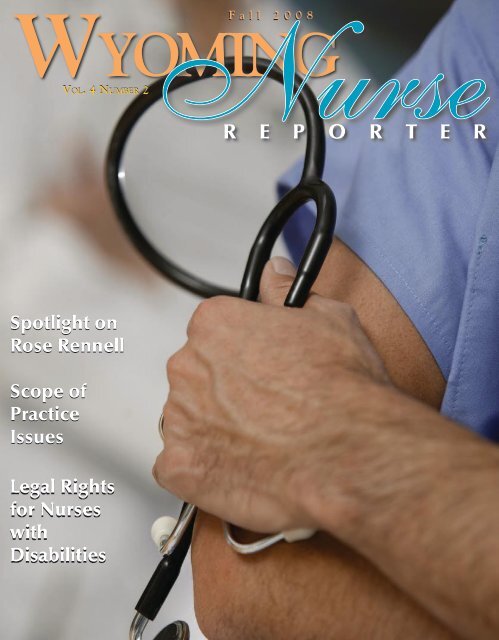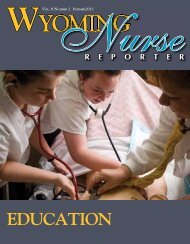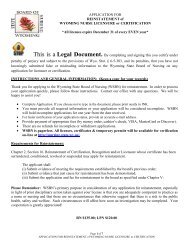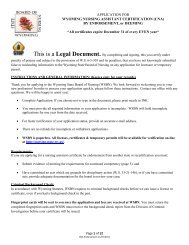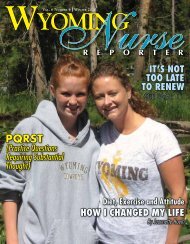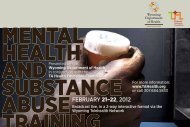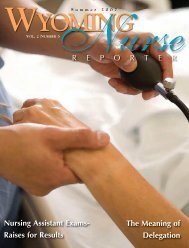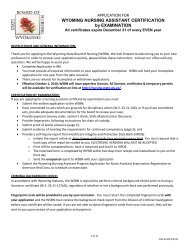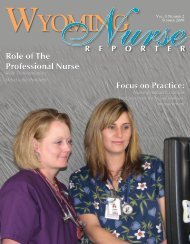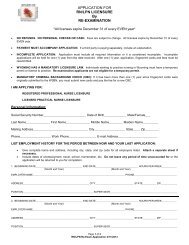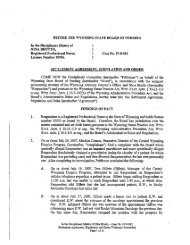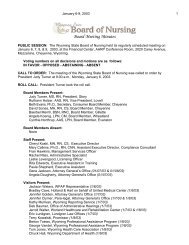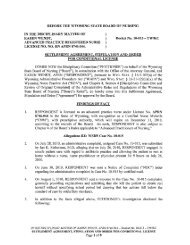Nurse Reporter Fall 2008 - Wyoming State Board of Nursing
Nurse Reporter Fall 2008 - Wyoming State Board of Nursing
Nurse Reporter Fall 2008 - Wyoming State Board of Nursing
You also want an ePaper? Increase the reach of your titles
YUMPU automatically turns print PDFs into web optimized ePapers that Google loves.
Wy o m i n gPublished by the<strong>Wyoming</strong> <strong>State</strong> <strong>Board</strong> <strong>of</strong> <strong>Nursing</strong>1810 Pioneer Ave.Cheyenne, <strong>Wyoming</strong> 82002Phone: 307-777-7601Fax: 307-777-3519Web Address: http://nursing.state.wy.usAgency Mission: The <strong>Wyoming</strong> <strong>State</strong> <strong>Board</strong> <strong>of</strong><strong>Nursing</strong> is responsible for the protection <strong>of</strong> the public’shealth, welfare, and safety through the regulation <strong>of</strong>nursing, nursing education, nursing practice, anddisciplinary standards. The responsibility <strong>of</strong> the <strong>Board</strong><strong>of</strong> <strong>Nursing</strong> is to implement a cost-effective and efficientsystem <strong>of</strong> regulation, which meets the consumerdemand for safe, competent, ethical practitioners <strong>of</strong>nursing which includes advanced practice nurses, registeredpr<strong>of</strong>essional nurses, licensed practical nurses,and certified nursing assistants.WE P O R T E R<strong>Nurse</strong>Spring <strong>2008</strong>Vo l. 4 Nu m b e r 1R“protecting the public through excellence in nursing...”T a b l e o f Co n t e n t s3 Disabled <strong>Nurse</strong>s in the Workplace5 Spotlight on Rose Rennell6 Scope <strong>of</strong> Practice Issues7 From the President <strong>of</strong> the <strong>Wyoming</strong> <strong>State</strong> <strong>Board</strong> <strong>of</strong> <strong>Nursing</strong>12 Disabled <strong>Nurse</strong>s Need GritEx e c u t i v e Di re c t o rMary Kay Goetter, MS, RNC, NEA-BCAssistant Ex e c u t i v e Di re c t o rPr a c t i c e a n d Ed u c a t i o n Co n s u l t a n tMary Beth Stepans, PhD, RNCo m p l ia n c e Co n s u l t a n tBridget Horne, BSN, RNFi n a n c i a l a n d Hu m a n Resources OfficerCindy StillahnEx e c u t i v e AssistantJoAnn ReidLi c e n s i n g Co o r d i na t o rLaVelle OjedaLi c e n s i n g Co o r d i na t o rMaxine HernandezDisciplinary AssistantDebra BallBo a r d o f Nu r s i n g MembersKellie Clausen, FNP, WHCNP, RN PresidentJennifer Zettl, RNVice-PresidentMarguerite Herman, ConsumerSecretaryKim Williamson, LPNMemberMarcie Burr, RNMemberJenny Heuck, MS, RNMemberTracy WasserburgerMember<strong>Wyoming</strong> <strong>Nurse</strong> <strong>Reporter</strong> does not necessarilyendorse advertisements contained herein. Thepublisher reserves the right to accept or rejectadvertisements for <strong>Wyoming</strong> <strong>Nurse</strong> <strong>Reporter</strong>.For Advertising Information:Greg Jonesgjones@pcipublishing.com501.221.9986 or 800.561.4686Created By:Publishing Concepts, Inc.Virginia Robertson, Presidentvrobertson@pcipublishing.comwww.thinkaboutitnursing.comPublishing Concepts, Inc.14109 Taylor Loop RoadLittle Rock, AR 72223EDITION 1417 If You re DisabledGreetingsf r o m t h eE x e c u t i v eD i r e c t o r ,M a r y Ka yG o e t t e rEditorial: Disabled <strong>Nurse</strong>s in the WorkplaceThe fall issue <strong>of</strong> the<strong>Wyoming</strong> <strong>Nurse</strong> <strong>Reporter</strong>is highlighting the topic <strong>of</strong>nurses with disabilities andtheir role in continuing tocontribute to the pr<strong>of</strong>ession.The current shortage<strong>of</strong> nurses in <strong>Wyoming</strong>, withits multitude <strong>of</strong> causativefactors (Gallagher, <strong>2008</strong>),prompts the examination<strong>of</strong> any and all reasonablesolutions to sustaining andincreasing the workforce.When considering thepool <strong>of</strong> nurses with varioushealth problems and disabilitieswho still desire tobe active working nurses, allstakeholders need to be proactivein considering howthe pr<strong>of</strong>ession is supportingthese individuals.As in all matters <strong>of</strong> regulation,it is necessary to consultthe law. The <strong>Wyoming</strong><strong>Nurse</strong> Practice Act (NPA)(<strong>Wyoming</strong> <strong>State</strong> <strong>Board</strong> <strong>of</strong><strong>Nursing</strong>, 2003) states in 33-21-146 (a): “The board <strong>of</strong>nursing may refuse to issue,or may suspend or revokethe license, certificate, ortemporary permit <strong>of</strong> anyperson, or to otherwise disciplineany licensee, uponpro<strong>of</strong> that the person: (iv)is unfit or incompetent topractice nursing by reason <strong>of</strong>negligence, habits or othercauses including but notlimited to: (A) Being unableto practice nursing withreasonable skill and safetyto patients by reason <strong>of</strong>physical or mental disability,or use <strong>of</strong> drugs, narcotics,chemicals or any othermind-altering material” (p.13) and (xi) “Has failed tosubmit to a mental, physicalor medical competencyexamination following aproper request by the boardmade pursuant to boardrules and regulations andthe <strong>Wyoming</strong> AdministrativeProcedure Act” (p.14). On the first reading <strong>of</strong>the law, it may appear toContinued on next pageW y o m i n g N u r s e R e p o r t e r 3
e fairly unflinching, but in fact, the NPAleaves significant room for interpretationon a case-by-case basis.First and foremost, each case must beconsidered individually to see if the licenseholder is “unfit or incompetent … topractice nursing with reasonable skill andsafety to patients.” Unfortunately, there isno national consensus on what constitutespr<strong>of</strong>ession-wide competencies and skillsfor nurses, which makes legal interpretation<strong>of</strong> this statement problematic (Helms,Jorgensen, and Anderson, 2006). Thedecision <strong>of</strong> whether a nurse is unfit or incompetentmust be a joint endeavor <strong>of</strong> theregulatory agency, in this case the <strong>Wyoming</strong><strong>State</strong> <strong>Board</strong> <strong>of</strong> <strong>Nursing</strong> (WSBN), theemployer, the nurse in question, and thenurse’s health care provider.In the event <strong>of</strong> substance abuse issues,other parts <strong>of</strong> the NPA become relevant;in many instances, law enforcementagencies are also involved in gatheringevidence and reviewing the case. Currently,45 nurses are enrolled in the <strong>Wyoming</strong>Pr<strong>of</strong>essional Assistance Program (WPAP)for treatment <strong>of</strong> substance abuse/chemicaldependency. At least that many nursesare represented in active open cases underinvestigation by the WSBN. Chemicaldependence is recognized as a disabilityunder the Americans with DisabilitiesAct (ADA); however, the ADA onlyprotects employees from discriminationif they are successfully rehabilitated andno longer abuse the substance in question(Snyder, <strong>2008</strong>). Illegal conduct, such asuse <strong>of</strong> illegal drugs or illegal use <strong>of</strong> legaldrugs, is not conduct for which the ADArequires reasonable accommodation orpermits a disability discrimination lawsuit.This is an important point when discussioncenters around enfolding nurses withdisabilities back into the workforce; nurseswith chemical dependency must no longerbe engaged in illegal activities and must beenrolled in the WPAP (or other rehabilitationprogram) in order to have the opportunityto retain licensure and be permittedto continue practice.However, there are many disabilityissues other than chemical dependencywhen considering how disabled or health-Continued from previous pagecompromised nurses may remain in theworkforce. In just my own personal experienceas a practicing nurse and nurse educator,I have worked with nurses or taughtnursing students affected by multiplehealth issues, whether or not they fullyqualified or identified themselves as beingdisabled: cerebral palsy, congenital limbreduction, hearing impairment, speechimpediment, musculoskeletal problemscausing chronic pain and compromisinggait or movement, Type I and II diabetes,and various mental health disorders such asattention deficit disorder (ADHD), depressionand bipolar disorder. Some <strong>of</strong> thesenurses and nursing students needed specialaccommodations (special stethoscopes forIn this issue <strong>of</strong> the <strong>Wyoming</strong> <strong>Nurse</strong><strong>Reporter</strong>, read the stories <strong>of</strong> nurses herein <strong>Wyoming</strong> who are struggling with thesevery questions. Ask yourself how youfeel about working with nurses who havehealth problems and/or disabilities. Considerhow each <strong>of</strong> us can provide “accommodations”for one another … sometimesas simple as <strong>of</strong>fering compassion and anopen mind.hearing impairment or a particular type<strong>of</strong> chair to support the back/spine). Mostdid not need anything other than understandingand compassionate peers andco-workers.Under specific circumstances, anemployer could attempt to raise questionsregarding a nurse’s fitness or competencyfor any <strong>of</strong> these health problems. Forexample, what if a diabetic nurse experiencedan unrecognized hypoglycemicepisode and made an error in caring for apatient? What if the nurse with a chronicback problem experienced a spasm whenmoving a patient and harmed the patientor exacerbated the injury and neededworkmen’s compensation? An employer, oreven co-workers, concerned with liabilitymay fret over any number <strong>of</strong> potential situationsand fear employing or working withnurses with health problems or disabilities,even if these employees are not asking forspecial accommodations. While employmentlaws and the ADA are designed toprotect the employee’s rights, one cannotlegislate attitudes and beliefs. The grayareas in law, regulation and even our ownpersonal beliefs leave a great deal <strong>of</strong> spacefor what course <strong>of</strong> action may be taken.In this issue <strong>of</strong> the <strong>Wyoming</strong> <strong>Nurse</strong><strong>Reporter</strong>, read the stories <strong>of</strong> nurses herein <strong>Wyoming</strong> who are struggling withthese very questions. Ask yourself howyou feel about working with nurses whohave health problems and/or disabilities.Consider how each <strong>of</strong> us can provide“accommodations” for one another …sometimes as simple as <strong>of</strong>fering compassionand an open mind.The WSBN is actively engaged inworkforce issues here in <strong>Wyoming</strong>. Aspart <strong>of</strong> our mission <strong>of</strong> public protection,the board is charged with regulation andlicensure <strong>of</strong> nursing pr<strong>of</strong>essionals in thestate to ensure a robust nursing workforcefor all <strong>of</strong> the people <strong>of</strong> <strong>Wyoming</strong>.We challenge all <strong>Wyoming</strong> employersand nursing pr<strong>of</strong>essionals to criticallyexamine the issue <strong>of</strong> including nurseswith health challenges and disabilities asvalued members <strong>of</strong> the healthcare team.We welcome your comments on this issue.ReferencesGallagher, T. (<strong>2008</strong>). <strong>Nurse</strong>s in demand:<strong>State</strong>ment <strong>of</strong> the problem. Casper,WY: <strong>Wyoming</strong> Department <strong>of</strong> Employment,Research and Planning o. DocumentNumber)Helms, L., Jorgensen, J., and Anderson,M. A. (2006). Disability law and nursingeducation: An update. Journal <strong>of</strong> Pr<strong>of</strong>essional<strong>Nursing</strong>, 22(3), 190-196.Snyder, E. K. (<strong>2008</strong>). Chemical dependency:Hospital not required to accommodaterestrictions re narcotics, no disabilitydiscrimination. Legal Eagle Eye for theNewsletter for the <strong>Nursing</strong> Pr<strong>of</strong>ession,16(1), 4.Administrative rules and regulations,(2003).4 W y o m i n g N u r s e R e p o r t e r
Rose Rennell, RN, MS, COHN EmployeeHealth <strong>Nurse</strong>, Campbell County MemorialHospital, Gillette, Wyo.A Rose is Not Just a RoseRose Rennell, RN, MS, COHNI am a nurse. I have always been a nurse.Even in childhood, when playing withneighborhood friends, I was the nurse bandagingimaginary wounds. I <strong>of</strong>ficially beganmy nursing career as a licensed practicalnurse in 1978. I moved to Gillette, Wyo., in1980. I had to wait for the associate degreenursing program to come to the Gillettecampus to continue towards my goal <strong>of</strong>being a registered nurse. By the time theprogram was ready to accept students, mycredits were too old to transfer. I was ableto earn credits by challenging many <strong>of</strong> thecourses and clinical requirements, but I stillhad to repeat some classes. As a mother <strong>of</strong>two growing children, maintaining full timeemployment with benefits was essential, soI completed most <strong>of</strong> the courses by takingnight classes. I enrolled in one or twoclasses a semester until I was accepted intothe associate degree program in January <strong>of</strong>1989.It was during fall break, October<strong>of</strong> that year, that my children (now youngteenagers) and I went to Rapid City tospend time with my family. We started ourreturn to Gillette on Sunday evening. Theweather turned colder, forming black ice onthe highway. As we passed the exit <strong>of</strong> Sundance,Wyo., my little Chevy S-10 pickuptook a sudden slide sideways, landed in theditch, and rolled over onto the ro<strong>of</strong>. I wasthrown partially out <strong>of</strong> the window. Thetruck rolled across my chest and dumped meface down in the ditch. This shattered myT4 and fractured T5 and T7. Thankfully,my children sustained only minor injuries.At that point, only two months fromgraduation, my world changed. I had a newname, T4 complete paraplegic.My co-workers, fellow students,instructors and friends never wavered intheir support. My rehabilitation includedmore than the physical preparation for mynew life. I was determined to finish my RN.With the help <strong>of</strong> a fellow nursing studentsending me typed lecture notes weekly andGillette campus instructors creating clinicalrotations, I did finish and graduated May1990. My focus on completing my nursingdegree kept me looking forward.The hospital where I had workedfor nine years did not know what to do withme. The idea <strong>of</strong> an RN in a wheelchair wasthinking way outside the box, and I kepthearing terms like “patient safety” and “bedsideaccessibility.” Our Infection Controlnurse, always the visionary, stepped forwardand proposed a new position called EmployeeHealth nurse. This would be a nursewho concentrated on meeting the healthand safety needs <strong>of</strong> the staff and has knowledge<strong>of</strong> the Occupational Safety and HealthAdministration (OSHA) and Centers forDisease Control and Prevention (CDC)requirements. I continue to hold this position,and it has proven to be challengingand extremely rewarding. I now take care <strong>of</strong>the staff that took care <strong>of</strong> me. Believe mewhen I say there is nothing “cushy” about a“desk job.”I continued my education thanksto the support and encouragement frommy manager. I completed my Bachelor <strong>of</strong>Science Degree in <strong>Nursing</strong> through the University<strong>of</strong> <strong>Wyoming</strong>’s RN to BSN programin 1997 and my Master <strong>of</strong> Science Degreealso from UW in 2002. I achieved nationalcertification in Occupational Health <strong>Nursing</strong>in 2001.Along the way, I met a mixture <strong>of</strong> supportand resistance for nursing from a wheelchair.Stereotypic attitudes are like blinders, preventingthe person from being seen beyondthe disability. I mostly ignore the doubtersand work around them. I have confidencein what I can do and know my limitations.The real beauty <strong>of</strong> nursing is the vast careerfields that are available. Bedside nursing isnot the only game in town.My disability has given me an insight tothe long lasting effects an injury can haveon the individual, the family, and financialstability. Workplace safety and prevention<strong>of</strong> work-related injuries is one <strong>of</strong> the mostimportant functions <strong>of</strong> my position. Whenan injury does occur, job accommodation isa viable option to keep the valued, skilledworker on the job. This is better for theemployer and the employee. If nothing else,I want to be living pro<strong>of</strong> that working with adisability can be a win-win situation.
S c o p e o f Pr a c t i c e Is s u e s• Advisory Opinion: 04-143, FNP PracticingPsych/Mental Health Setting-APNAlthough members <strong>of</strong> the <strong>Board</strong> acknowledgethe barriers to obtaining adequate care forchildren with mental health issues, they reaffirmedAdvisory Opinion Number 04-143 (FNPPracticing Psych/Mental Health Setting-APN).This decision is based upon documents describingthe scope <strong>of</strong> practice and core competenciesidentified by the National Association <strong>of</strong> Clinical<strong>Nurse</strong> Specialists and the National Organization<strong>of</strong> <strong>Nurse</strong> Practitioners. This opinion, drafted July14, 2004, is written as follows: “It is not withina Family <strong>Nurse</strong> Practitioner’s (FNP) scope topractice as a Clinical Specialist (CS) or <strong>Nurse</strong>Practitioner (NP) in Psychiatric/Mental Health(P/MH) nursing. The FNP may only practicewithin the standards <strong>of</strong> practice promulgated bythe national accreditation agencies representingFNPs. If the FNP wishes to practice as a CS orNP in Psych/Mental Health, they must have theeducational preparation (degree/post graduatecertificate in psych/mental health nursing). Ifthe FNP is appropriately certified by the ANCCfor practice as an Advance Practice <strong>Nurse</strong> in P/MH nursing, there is no reason that the individualcan not practice in P/MH setting, as certificationis highly recommended.”• Advisory Opinion: 08-186, Procedural Sedationand Analgesia in the Emergency DepartmentFollowing the presentation <strong>of</strong> the informationfrom the Emergency <strong>Nurse</strong>s Association, thearticle from the American Family Physician(2005) as well as the consensus statement on thistopic, the <strong>Board</strong> <strong>of</strong> <strong>Nursing</strong> made the followingdecisions:1. Rescind Advisory Opinion Number 06-163(Administration <strong>of</strong> Anesthetic Agents such asProp<strong>of</strong>ol, Etomidate and Ketamine by Rns for IVConscious Sedation).2. Adopt the Procedural Sedation and Analgesiain the Emergency Department Consensus <strong>State</strong>mentas endorsed by the following organizations:Air and Surface Transport <strong>Nurse</strong>s Association,American Academy <strong>of</strong> Emergency Medicine,American Association <strong>of</strong> Critical Care <strong>Nurse</strong>s,American College <strong>of</strong> Emergency Physicians,American Radiological <strong>Nurse</strong>s Association,American Society for Pain Management <strong>Nursing</strong>,Emergency <strong>Nurse</strong>s Association, NationalAssociation <strong>of</strong> Children’s Hospitals and RelatedInstitutions.The Procedural Sedation and Analgesia in theEmergency Department advisory opinion iswritten as follows: “The <strong>Wyoming</strong> <strong>State</strong> <strong>Board</strong><strong>of</strong> <strong>Nursing</strong> adopted the Procedural Sedation Consensus<strong>State</strong>ment as endorsed by the followingorganizations: Air and Surface Transport <strong>Nurse</strong>sAssociation, American Academy <strong>of</strong> EmergencyMedicine, American Association <strong>of</strong> Critical Care<strong>Nurse</strong>s, American College <strong>of</strong> Emergency Physicians,American <strong>Nurse</strong>s Association, AmericanRadiological <strong>Nurse</strong>s Association, AmericanSociety for Pain Management <strong>Nursing</strong>, Emergency<strong>Nurse</strong>s Association, National Association<strong>of</strong> Children’s Hospitals and Related Institutions.Procedural Sedation Consensus <strong>State</strong>mentThe immediate availability <strong>of</strong> interventionsincluding procedural sedation is critical to servingthe needs <strong>of</strong> our patients. Preserving life,restoring health, and alleviating suffering havebeen fundamental to the practice <strong>of</strong> nursing andmedicine for centuries. We are challenged ashealth care pr<strong>of</strong>essionals to provide this care in amanner that meets the Institute <strong>of</strong> Medicine’s SixQuality Aims <strong>of</strong> safe, effective, timely, efficient,equitable, and patient centered care. Patientswith emergency medical conditions frequentlyexperience significant treatable pain and anxiety.There is ample evidence to support the routineuse <strong>of</strong> procedural sedation by appropriatelytrained and credentialed emergency nurses andphysicians.PRINCIPLES FOR PROCEDURAL SEDA-TION IN EMERGENCY CARE SETTINGS➢Patients have a right to expect that:o their survival and recovery will always be toppriorities;o their care will be provided in a safe and patientcentered manner;o their comfort will be assessed and pain managedin an equitable, timely, and efficient manner;o their care in emergency care settings will beconsistent with current medical knowledge andpractice;o their emergency caregivers will be appropriatelytrained and credentialed; ando they will be provided sufficient information,when possible, to allow them to participate intherapeutic decisions and provide informedconsent.➢ The primary goal <strong>of</strong> procedural sedation forpatients in emergency care settings is to managepain and anxiety while facilitating immediateinterventional procedures.➢ The response to sedating medications followsa broad continuum that varies from patient topatient. Care must be customized to both thepatient and the clinical situation, and caregiversmust be able to recognize and manage potentialcomplications.➢ Procedural sedation is safe and effective whenperformed by appropriately trained, credentialed,and supported emergency nurses and physicians.We, the undersigned organizations, agree:1. Medications including, but not limited to,etomidate, prop<strong>of</strong>ol, ketamine, fentanyl, andmidazolam are utilized by healthcare pr<strong>of</strong>essionalsto facilitate management <strong>of</strong> a continuum <strong>of</strong>painful conditions. These extend from simplepain management and maintenance sedation tomoderate to deep sedation for painful procedures.Because <strong>of</strong> the myriad ways these medicationsmight be used, it is best to focus on the goal<strong>of</strong> the intervention rather than the medicationitself.2. Procedural sedation is defined as a technique<strong>of</strong> administering sedatives or dissociative agentswith or without analgesics to induce a state thatallows the patients to tolerate an unpleasantprocedure while maintaining cardiorespiratoryfunction. (American College <strong>of</strong> EmergencyPhysicians [ACEP] Clinical Policy for ProceduralSedation and Analgesia in the Emergency Department,Annals <strong>of</strong> Emergency Medicine 2005)3. Procedural sedation medications may beadministered by a registered nurse (RN) in thepresence <strong>of</strong> a physician, an advanced practiceregistered nurse, or other health care pr<strong>of</strong>essionalcredentialed and privileged for procedural sedation.RNs administering such medications mustpossess the training and competencies describedin item four below.4. Administration <strong>of</strong> medications for proceduralsedation by a RN is a specialized skill thatrequires specific knowledge and competenciesincluding, but not limited to:a. An understanding <strong>of</strong> the principles <strong>of</strong> oxygendelivery, transport and uptake, and respiratoryphysiology.b. Demonstrated competency in airway managementappropriate to the age <strong>of</strong> the patientincluding monitoring patient oxygenation andventilation (e.g. skin color, respiratory rate, pulseoximetry, secondary confirmation <strong>of</strong> endotrachealtube placement), initiation <strong>of</strong> resuscitative measures,and utilization <strong>of</strong> oxygen delivery devices(e.g. nasal cannula, mask, basic airway techniques,oral/nasal airways, bag valve mask).c. Demonstrated knowledge <strong>of</strong> anatomy, physiology,pharmacology, cardiac dysrhythmia recognition,and complications related to proceduralsedation and analgesia.d. Ability to initiate cardiac resuscitation procedures(e.g. CPR, cardioversion, defibrillation).e. Identification and differentiation <strong>of</strong> the variouslevels <strong>of</strong> sedation.f. Demonstrated competence in pre-procedural,procedural, and post-procedural nursing care fromthe initial patient evaluation to patient discharge(e.g. patient assessment and monitoring, IV fluidadministration, medication administration).g. The ability to recognize complications andintervene appropriately.h. Knowledge <strong>of</strong> the legal/liability ramificationsassociated with an independently licensed RNadministering procedural sedation.5. Procedural sedation requires the presence<strong>of</strong> two licensed pr<strong>of</strong>essionals at the bedside.One licensed pr<strong>of</strong>essional must be a RN whosecompetency in procedural sedation has been verified.This RN may administer the medication ormonitor the patient and must not be involved inperforming the procedure.Health care pr<strong>of</strong>essionals monitoring the patientundergoing procedural sedation must not haveother responsibilities that would compromisetheir ability to adequately monitor the patientbefore, during, and after the procedure.6. Resuscitation equipment and supplies must beage appropriate and readily available for the patientundergoing any procedure. At a minimum,equipment should include oxygen and oxygen deliverydevices, suction devices and suction source,cardiac and pulse oximetry monitoring devices,defibrillator, oral/nasal airways, intubation equipment,alternative airways, bag-valve mask device,equipment to allow secondary confirmation <strong>of</strong>endotracheal tube placement, reversal agents andACLS medications. (ACEP
From the President <strong>of</strong> the <strong>Wyoming</strong> <strong>State</strong><strong>Board</strong> <strong>of</strong> <strong>Nursing</strong>Kellie Clausen, RN-C, WHCNP, FNPThis issue <strong>of</strong> the <strong>Wyoming</strong> <strong>Nurse</strong><strong>Reporter</strong> begins an effort by the <strong>Wyoming</strong><strong>State</strong> <strong>Board</strong> <strong>of</strong> <strong>Nursing</strong> to communicate ourpurpose and message to our license holders.Look for articles during the coming monthsabout the different committees, responsibilitiesand charges <strong>of</strong> the board. ExecutiveOfficer Mary Kay Goetter will share her experience,education and enthusiasm as well.As we begin another license cycle, Iencourage everyone to renew early. Ournew online renewal for RNs (only) will beavailable this fall, and we look forward toimproved efficiency and ease <strong>of</strong> use.Several <strong>Board</strong> members and staff recentlyattended the 30th Annual Meeting <strong>of</strong> theNational Council <strong>of</strong> <strong>State</strong> <strong>Board</strong>s <strong>of</strong> <strong>Nursing</strong>.This is my third year <strong>of</strong> attendance atthe Annual Meeting, and I am awed by theprivilege and by the people I meet. Althoughour numbers are small in comparisonto many other states, our issues are verysimilar. I am reminded how fortunate we arein <strong>Wyoming</strong> to have such forward thinkingnursing legislation and also to live in such afiscally sound state.On the issue <strong>of</strong> nursing legislation, theRules and Regulations <strong>of</strong> the <strong>Wyoming</strong><strong>State</strong> <strong>Board</strong> <strong>of</strong> <strong>Nursing</strong> are being rewrittenas you are reading this magazine. They willbe out for public comment very soon. Pleaseshare your comments on these rules as theybecome available. Although your board ismade up <strong>of</strong> a diverse group <strong>of</strong> nurses and anincredibly competent and talented consumermember, we benefit from the input <strong>of</strong> allthe stakeholders in the state. <strong>Nursing</strong> isevolving at an ever faster pace, and if we areto keep up, we need input. It is encouragingthat our rules are a living documentand respond to the needs <strong>of</strong> the people <strong>of</strong><strong>Wyoming</strong>.I was recently attending a non-nursingsocial function, and standing in line at thebuffet, a woman struck up a conversationwith me about my pr<strong>of</strong>ession. When I toldher I am a <strong>Nurse</strong> Practitioner, she sharedthis story with me and gave me permissionto share it with you as well: While needingto visit her <strong>Nurse</strong> Practitioner last year, shewas informed the NP was on vacation butsomeone else would be filling in. She wasshown to an exam room as usual and a veryyoung, well-dressed and obviously nervousMountain ViewRegional Hospitalis the premiereneurosurgical andspine hospital inCasper, WY andthe Rocky MountainRegion. We <strong>of</strong>ferleading-edge surgicaltreatments—andthe highest levels<strong>of</strong> comfort andcare—in a healingenvironment.Our incomparablevision <strong>of</strong> serviceexcellence has leda highly motivatedleadership teamto hand selectexceptional nursesfor our patients.young man came in to see her. In an effortto put him at ease, she asked how long hehad been a <strong>Nurse</strong> Practitioner, and he toldher, “I am not a <strong>Nurse</strong> Practitioner, I am aphysician.”At Mountain View Regional Hospital,the patient always comes first.Our nurses want to help, and they believe in the healingpower <strong>of</strong> human touch. This group <strong>of</strong> pr<strong>of</strong>essionalshas come together to make a difference in theirpatient’s lives. At Mountain View Regional Hospital,nurses deliver uncompromised care in an environment<strong>of</strong> clinical excellence.We are accepting applications from nurses with 1 to2 years experience in Neurosurgical, Surgical, or CriticalCare/PACU/ER. If you are interested in joining ourmotivated and enthusiastic team, send your resume forconsideration to Jenni Milner at jmilner@nshinc.com
St. John’s Medical Center <strong>Nurse</strong>Practitioner, Connie JohnsonSt. John’s Medical Center <strong>Nurse</strong> Practitioner, Connie Johnson, has been chosen for a one yearOncology fellowship at the M.D. Anderson Cancer Center in Houston, Texas.The appointment will involve directly working with Oncology <strong>Nurse</strong> Practitioners andOncologists with exposure to the entire spectrum <strong>of</strong> oncology care from prevention to end <strong>of</strong> life.The fellowship will also include classes at the University <strong>of</strong> Texas Health Science Center at Houstonleading to a post-masters oncology degree.Johnson has been employed by St. John’s Medical Center located in Jackson, Wyo., for six years.She also sees patients at the 4 Peaks Clinic in Driggs, Idaho, as a Family <strong>Nurse</strong> Practitioner. Johnsonplans to return to Jackson upon completion <strong>of</strong> the fellowship, where she will work as an Oncology<strong>Nurse</strong> Practitioner at the Oncology clinic.Johnson is a board member for the <strong>Wyoming</strong> affiliate <strong>of</strong> Susan G. Komen for the Cure. She also isa member <strong>of</strong> the Susan G. Komen Advocates in Science Program, a committee that reviews nationalbreast cancer research grants.What is NURSYS?Nur Rajwany, MSNCSBN, Director Information TechnologyDawn M. Kappel, MANCSBN, Director Marketing and CommunicationIf your organization has a need to ensure safety and save time while increasing efficiency in regard to verification <strong>of</strong> a nurselicense and/or checking discipline status for employment decisions, then look no further than the NCSBN Nursys® (www.nursys.com) computer system. Nursys provides licensure verification and discipline status instantly, allowing for faster informedemployment decisions.Nursys contains personal, licensure, education, verification and discipline information supplied as regular updates byboards <strong>of</strong> nursing in the U.S. and its territories. All boards <strong>of</strong> nursing, including non-licensure participating boards <strong>of</strong> nursing,have access to information within Nursys and are able to enter and edit discipline information. Nursys provides centralizedlicense information to boards <strong>of</strong> nursing, which in turn, use this data to verify applicant license information, enter and reviewdisciplinary actions and send electronic communications between boards <strong>of</strong> nursing for information requests.NCSBN also provides public access to Nursys for the purposes <strong>of</strong> licensure verification. Nursys verifies license and disciplinestatus, including discipline against the privilege <strong>of</strong> working in a <strong>Nurse</strong> Licensure Compact (NLC) party state.8 W y o m i n g N u r s e R e p o r t e r
The following is an example <strong>of</strong> verification <strong>of</strong> a multistate license issued by Arkansas. This nurse has no discipline action taken againsthis license and no privilege to practice discipline taken by any other NLC state.When a licensed nurse applies for licensure in another state, verification <strong>of</strong> existing or previous licenses may be required. A nurse can useNursys to request verification <strong>of</strong> licensure from a Nursys licensure participating board. For example, the <strong>Wyoming</strong> <strong>State</strong> <strong>Board</strong> <strong>of</strong> <strong>Nursing</strong>licensure participates in Nursys; therefore, licensed nurses in <strong>Wyoming</strong> can use Nursys for verifying licensure verification to another board<strong>of</strong> nursing by visiting www.nursys.com. If the nurse needs to request license verification from a non-licensure participating board, the nurseshould contact the board <strong>of</strong> nursing where she/he holds license.Verification can be requested by completing an online Nursys verification request application (there is a $30.00 fee for this service).Once verification has been processed, the verification information is available to all boards <strong>of</strong> nursing for 90 days. Multiple applications canbe fulfilled by the same verification request and fee, as long as it is accessed by the board <strong>of</strong> nursing within the 90-day period. Nursys licenseverification is made available to boards <strong>of</strong> nursing immediately upon completion <strong>of</strong> the online verification process, which expedites theendorsement process for nurses.Employers can verify multiple licenses including all NLC party states within minutes and pay only for those reports they select. Eachreport is available for printing directly from the Web browser upon payment. A copy <strong>of</strong> the report and receipt are automatically sent bye-mail upon completion <strong>of</strong> the transaction. There are additional boards that have signed agreements to provide licensure data throughNursys; this data will be available in the coming months.For more information, e-mail NursysS@ncsbn.org,call 312.525.3780 or visit www.nursys.com.Information on the NLC is available by visiting: https://www.ncsbn.org/nlc.htm.For a list <strong>of</strong> licensure participating <strong>Board</strong>s <strong>of</strong> <strong>Nursing</strong>, visit: (https://www.nursys.com/includes/processing/psPart<strong>State</strong>.aspW y o m i n g N u r s e R e p o r t e r 9
Legal Rights for <strong>Nurse</strong>s with DisabilitiesMarcia L. Dale, RN, EdD, FAANThe first legal movement to helppeople with disabilities was the passage<strong>of</strong> the Rehabilitation Act <strong>of</strong> 1973. Thiswas followed by the Americans withDisabilities Act <strong>of</strong> 1990. These two lawsgave nurses weapons with which to fightdiscrimination against practices that keptthem from obtaining or keeping employment.“The Rehab Act prohibits discriminationagainst individuals with anyhandicap by any entity receiving federalfunding. Thus, any healthcare employerreceiving Medicare payments or that is inany way connected to the federal governmentor federal funding is covered underthis law” (Matt, 2006, p. 1). Employersare required to make reasonable accommodationsfor qualified applicants withdisabilities. This means that a nurse whohas the skills, experience, and educationcalled for in an available position, with orwithout reasonable accommodation, maybe considered qualified. But, “for an individualto be protected by the Rehab Actand the ADA, they must have a physicalor mental impairment that substantiallylimits one or more major life activity”(Matt, 2006, p. 3).Reasonable accommodation must beinitiated by the nurse. It might be assimple as making the facility accessible orit might be job restructuring to part-time,modifying equipment, or the provision<strong>of</strong> a reader or interpreter. It all mustbalance out in cost versus benefit to theemployer and employee (Lyons, 1995).Lyons. V. (1995). Legal Aid Society.Maheady, D. C. (2006) Leave No<strong>Nurse</strong> Behind: <strong>Nurse</strong>s Working with disabilities.New York: iUniverse, Inc.Matt, S. B. (2006). Reasonableaccommodation: Legal protectionfor nurses with disabilities in In D.C.Maheady, Leave no nurse behind: <strong>Nurse</strong>sworking with disabilities (pp. 1-7). NewYork: iUniverse, Inc.Ad Space Available10 W y o m i n g N u r s e R e p o r t e r
Disabled <strong>Nurse</strong>sNeed GritMarcia L. Dale, RN, EdD, FAANMarcia L. Dale, RN, EdD, FAANIn the last issue <strong>of</strong> <strong>Wyoming</strong> <strong>Nurse</strong><strong>Reporter</strong>, there was a letter to the editorwritten by Trudy Craft, a nurse witha significant hearing problem. Shebrought to light that a disability doesnot end the contribution a nurse canmake to the pr<strong>of</strong>ession. She is an example<strong>of</strong> a nurse who has found a nichefor her skills, in spite <strong>of</strong> being hearingimpaired. The question she raises is,why are disabled nurses not granted theopportunity to practice when a nursingshortage exists and will continue toonly get worse? A 2002 U.S. CensusBureau report stated that 56 percent <strong>of</strong>people ages 21 to 64 who had a disabilitywere employed at some point duringthe year prior to the report, comparedto an 88 percent employment ratefor those with no disabilities (Spader,2007). This issue <strong>of</strong> The <strong>Wyoming</strong><strong>Nurse</strong> <strong>Reporter</strong> addresses severalareas concerning disabilities.The number <strong>of</strong> nurses whoare disabled is not known,and these data are notavailable in <strong>Wyoming</strong>.Some nurses and/or students do not want to disclosetheir disability for fear <strong>of</strong> terminationor denial <strong>of</strong> admission to a school <strong>of</strong>nursing. Others may be involved in alawsuit and are not at liberty to discusstheir disabilities. The term “be ableto perform the essential functions” <strong>of</strong>a nurse is frequently used as a criterionfor acceptance into a position <strong>of</strong>employment or into a nursing programand is the criterion for whether or not aperson is disabled. The reasons for thisgroup <strong>of</strong> nurses not being utilized toaddress the nursing shortage are numerous,but the safety issue is the most predominant.Barriers are set up because<strong>of</strong> the essential functions identified byemploying agencies.The recent emphasis on veteransreturning from war with severe disabilitieshas shown how survivors adaptto their afflictions. It is amazing whatthey can accomplish through sheereffort. <strong>Nurse</strong>s are no different. Theyare problem solvers who can overcometheir disability with innovation.However, because <strong>of</strong> the emphasis onpatient safety, regulations became morestringent. In 1990, the Americans withDisabilities Act was passed. This wasintended to make life more equal forpeople with disabilities. However, thelegal interpretation and the meaning<strong>of</strong> reasonable accommodations havebeen interpreted so differently thatadmission to schools and hiring byemployers has been inconsistent.Somestudents with disabilities have beenadmitted and graduated only to havedifficulty finding employment becausethe institution is unwilling to makeaccommodations.The disabilities that nurses havemay result from a birth defect, injuriesfrom lifting a patient, violence inflictedby patients, exposure to latex, hepatitis,HIV, a car accident, or on andon. These disabilities are no differentthan those found in the general public.However, what these nurses do havegoing for them is an understanding <strong>of</strong>what it is like to navigate the healthcare system, how to adjust to a disability,the feelings and concerns <strong>of</strong> livingwith a disability, and the mind set ittakes to overcome the imposed limitations.Education and accommodationare the keys for disabled nurses to opennew doors.ReferencesSpader, C. (2007, January 1).disAbled nurses: Education andaccommodation are the keys toincorporating RNs with disabilities.<strong>Nursing</strong>Spectrum <strong>Nurse</strong>Week. RetrievedJune 23, <strong>2008</strong>, from http://include.nurse.com/apps/pbcs.dll/article?AID=200761225005Carol, R. (n.d.). <strong>Nurse</strong>s with disabilities.Minority <strong>Nurse</strong>.com. RetrievedJune 23, <strong>2008</strong>, from http://www.minoritynurse.com/features/nurse_emp/01-27-02h.html
THE STRENGTH TO HEALand focus on what matters most.If what matters most to you is the care <strong>of</strong> your patients, we’ve got an extra bonus for you. Asign-on bonus <strong>of</strong> $20,000 to $30,000. Or you can opt for a $10,000 bonus and up to $114,900to repay your education loans. Qualified nurses can continue their education and earn amaster’s or doctoral degree. You’ll serve our Soldiers, their Families and yourself.To learn more about the U.S. Army Health Care Team, call SFC Kristine Kettlewell at 303-873-0491, email kristine.kettlewell@usarec.army.mil, or visit healthcare.goarmy.com/info/ncra1.© 2007. Paid for by the United <strong>State</strong>s Army. All rights reserved.The Beaches <strong>of</strong> CorpusChristi TXAll RNs & New Grads!Up to $7,500 Sign-on/Relo Pay up to $39.25 (w/Shift Diff)Ask about $11hr premium15% eves, 25% night Shift Diffs,Day Shifts Available!24hr Onsite DaycareClin Adv Pgm–to $500 monthExcellent Benefits Package!3k yr Tuition AssistanceNo <strong>State</strong> Income Taxes=more $San Antonio and Houston alsoavailableThe Beach – You Deserve ItContact Jeff Martin1-800-304-3095, x16jmartin@beck-field.comCONTINUING EDUCATION COURSES @ LEARNINGEXT.COMAcclimation <strong>of</strong> International <strong>Nurse</strong>s intoUS <strong>Nursing</strong> Practice6.6 Contact Hours | $40Confronting ColleagueChemical Dependency3.3 Contact Hours | $20Delegating Effectively4.2 Contact Hours | $25Disciplinary Actions: What Every <strong>Nurse</strong>Should Know4.8 Contact Hours | $29Diversity: Building Cultural Competence6.0 Contact Hours | $36UNLIMITED, 24-HOUR ACCESSTO ENGAGING NURSING CE CONTENT@ LEARNINGEXT.COMDocumentation: A Critical Aspect <strong>of</strong> Client Care5.4 Contact Hours | $32End-<strong>of</strong>-Life Care and Pain Management3.0 Contact Hours | $18Ethics <strong>of</strong> <strong>Nursing</strong> Practice4.8 Contact Hours | $29Medication Errors: Detection & Prevention6.9 Contact Hours | $41<strong>Nurse</strong> Practice Acts CE CoursesParticipants: AR, IA, ID, KY, MA, MN,MO, NC, ND, NM, NV, OH, VA, WV-PN/RN2.0 Contact Hours | $12Patient Privacy5.4 Contact Hours | $32Pr<strong>of</strong>essional Accountability& Legal Liability for <strong>Nurse</strong>s5.4 Contact Hours | $32Respecting Pr<strong>of</strong>essional Boundaries3.9 Contact Hours | $23Sharpening Critical Thinking Skillsfor Competent <strong>Nursing</strong> Practice3.6 Contact Hours | $22E-LEARNING FOR THE NURSING COMMUNITYW y o m i n g N u r s e R e p o r t e r 13
S c o p e o f Pr a c t i c e Is s u e sGuidelines for Equipment and Supplies forUse in Pediatric Patients in the ED, 2000;Alaska <strong>Board</strong> <strong>of</strong> <strong>Nursing</strong> Advisory Opinionon <strong>Nurse</strong> Administration <strong>of</strong> Sedating andAnesthetic Agents, 2007.)7. Written policies, procedures, clinicalguidelines, and protocols for proceduralsedation should be in place in the institution.These policies should be age appropriate andshould include, but not be limited to:➢Equipment and supplies➢Mandatory education and competencyvalidation➢Risk management➢Quality monitoring to include patientoutcomes➢ Required documentation********************************ADDENDUMProcedural Sedation Consensus <strong>State</strong>mentDefinitions:Advanced Practice Registered <strong>Nurse</strong> (APRN)is an umbrella term given to a RN whohas met advanced educational and clinicalpractice requirements beyond the two to fouryears <strong>of</strong> basic nursing education required <strong>of</strong>all RNs. APRNs include nurse practitioners,clinical nurse specialists, nurse anesthetists,and nurse midwives. <strong>Nurse</strong> practice acts varywidely among states. They define the scope<strong>of</strong> practice for APRNs within that particularstate. (American <strong>Nurse</strong>s Association [ANA]<strong>Nursing</strong> Facts, www.nursingworld.org)Certified Registered <strong>Nurse</strong> Anesthetists aremaster’s prepared advanced practice nurseswho provide anesthetics to patients in everypractice setting and for every type <strong>of</strong> surgeryor procedure. (http://www.aana.com)Credentialing is a term applied to processesused to designate that an individual, program,institution or product have met establishedstandards set by an agent (governmental ornon-governmental) recognized as qualifiedto carry out this task. The standards maybe minimal and mandatory or above theminimum and voluntary. Licensure, registration,accreditation, approval, certification,recognition or endorsement may be used todescribe different credentialing processes, butthis terminology is not applied consistentlyacross different settings and countries. Credentialsare marks or “stamps” <strong>of</strong> quality andachievement communicating to employers,payers, and consumers what to expect froma “credentialed” nurse, specialist, course orprogram <strong>of</strong> study, institution <strong>of</strong> higher education,hospital or health service, or healthcareproduct, technology, or device. Credentialsmay be periodically renewed as a means <strong>of</strong>assuring continued quality, and they may bewithdrawn when standards <strong>of</strong> competenceor behavior are no longer met. (Styles andAffara, 1997, International Council <strong>of</strong> <strong>Nurse</strong>sFact Sheet, http://www.icn.ch/matters_credentialing_print.htm)Deep sedation/Analgesia is a drug-induceddepression <strong>of</strong> consciousness during whichpatients cannot be easily aroused but respondpurposefully following repeated or painfulstimulation. The ability to independentlymaintain ventilatory function may be impaired.Patients may require assistance inmaintaining a patent airway, and spontaneousventilation may be inadequate. Cardiovascularfunction is usually maintained. (AmericanSociety <strong>of</strong> Anesthesiologists [ASA] policystatement on Continuum <strong>of</strong> Depth <strong>of</strong> SedationDefinition <strong>of</strong> General Anesthesia andLevels <strong>of</strong> Sedation/Analgesia, Approved byASA House <strong>of</strong> Delegates on October 13,1999, and amended on October 27, 2004.)Dissociative agents/dissociative sedation isdescribed as a “trancelike cataleptic statecharacterized by pr<strong>of</strong>ound analgesia andamnesia, with retention <strong>of</strong> protective airwayreflexes, spontaneous respirations, and cardiopulmonarystability. (American College<strong>of</strong> Emergency Physicians [ACEP] ClinicalPolicy for Procedural Sedation and Analgesiain the Emergency Department, Annals <strong>of</strong>Emergency Medicine 2005.)General anesthesia is a drug-induced loss <strong>of</strong>consciousness during which patients are notarousable, even by painful stimulation. Theability to independently maintain ventilatoryfunction is <strong>of</strong>ten impaired. Patients <strong>of</strong>tenrequire assistance in maintaining a patentairway, and positive pressure ventilation maybe required because <strong>of</strong> depressed spontaneousventilation or drug-induced depression<strong>of</strong> neuromuscular function. Cardiovascularfunction may be impaired. (ASA policy statementon Continuum <strong>of</strong> Depth <strong>of</strong> SedationDefinition <strong>of</strong> General Anesthesia and Levels<strong>of</strong> Sedation/Analgesia, Approved by ASAHouse <strong>of</strong> Delegates on October 13, 1999, andamended on October 27, 2004.)Minimal sedation (Anxiolysis) is a druginducedstate during which patients respondnormally to verbal commands. Althoughcognitive function and coordination maybe impaired, ventilatory and cardiovascularfunctions are unaffected. (ASA policy statementon Continuum <strong>of</strong> Depth <strong>of</strong> SedationDefinition <strong>of</strong> General Anesthesia and Levels<strong>of</strong> Sedation/Analgesia, Approved by ASAHouse <strong>of</strong> Delegates on October 13, 1999, andamended on October 27, 2004.)Moderate sedation/Analgesia (ConsciousSedation) is a drug-induced depression<strong>of</strong> consciousness during which patientsrespond purposefully to verbal commands,either alone or accompanied by light tactilestimulation. No interventions are required tomaintain a patent airway, and spontaneousventilation is adequate. Cardiovascular functionis usually maintained. (ASA policy statementon Continuum <strong>of</strong> Depth <strong>of</strong> SedationDefinition <strong>of</strong> General Anesthesia and Levels<strong>of</strong> Sedation/Analgesia, Approved by ASAHouse <strong>of</strong> Delegates on October 13, 1999, andamended on October 27, 2004.)Presence as used in the statement “in thepresence <strong>of</strong> a physician, advanced practiceregistered nurse, or other health care pr<strong>of</strong>essionaldescribes the location <strong>of</strong> the healthcare pr<strong>of</strong>essional” as being physically presentat the patient’s bedside or within the confines<strong>of</strong> the patient’s immediate treatment space.Privilege is an exceptional or extraordinaryright, immunity or exemption belonging toa person in virtue <strong>of</strong> their <strong>of</strong>fice or status.Clinical privileges include, as appropriate tothe organization, privileges, membership onthe medical staff and other circumstancespertaining to the furnishing <strong>of</strong> medical careunder which a physician, dentist or otherlicensed health care practitioner is permittedto furnish such care by a health plan or by afederal or state agency that either administersor provides payment for the delivery <strong>of</strong> healthcare services. (http://www.oig.hhs.gov/authorities/docs/datacollection.pdf)Procedural sedation is defined as the technique<strong>of</strong> administering sedatives or dissociativeagents with or without analgesics toinduce a state that allows the patient to tolerateunpleasant procedures while maintainingcardiorespiratory function. (ACEP clinicalpolicy for procedural sedation and analgesiain the emergency department – Annals <strong>of</strong>Emergency Medicine 2005.)Six Quality Aims as defined by the Institute<strong>of</strong> Medicine are:• Safe: Avoiding injuries to patients fromthe care that is intended to help them.• Effective: Providing services based onscientific knowledge to all who could benefitand refraining from providing services tothose not likely to benefit, thereby avoidingunder use and overuse, respectively.• Patient-centered: Providing care that isrespectful <strong>of</strong> and responsive to individualpatient’s preferences, needs, and values andensuring that patient values guide all clinicaldecisions.• Timely: Reducing waits and sometimesharmful delays for both those who receiveand those who give care.• Efficient: Avoiding waste, including waste<strong>of</strong> equipment, supplies, ideas, and energy.• Equitable: Providing care that does notvary in quality because <strong>of</strong> personal characteristicssuch as gender, ethnicity, geographiclocation and socioeconomic status. (Crossingthe Quality Chasm, IOM Report. NationalAcademies Press, 2001.)Continued on page18
Representing the Public as a Consumer on the<strong>State</strong> <strong>Board</strong> <strong>of</strong> <strong>Nursing</strong>Marguerite HermanI represent the consumer on the <strong>Wyoming</strong><strong>Board</strong> <strong>of</strong> <strong>Nursing</strong> and am constantlyimpressed with the commitment <strong>of</strong> theboard to the goal <strong>of</strong> assuring public healthand safety through regulation <strong>of</strong> the nursingpr<strong>of</strong>ession.I came to the board with a high regardfor nurses, derived from my work withthem on breastfeeding issues (I am astrong advocate), and that regard hasonly been enhanced during my 1 ½ yearson the board. I continue to admire boardmembers, the new and past executive <strong>of</strong>ficersand staff.What I bring to the board is a backgroundin journalism, education, lobbyingand other advocacy work. I bring theviewpoint <strong>of</strong> the consumer who may notknow all the technical details <strong>of</strong> medicalcare but who appreciates nurses’ pride intheir pr<strong>of</strong>ession and in giving quality care.I have an undergraduate degree in Englishfrom Colorado College and masters’degrees in journalism (University <strong>of</strong> SouthCarolina) and education (University <strong>of</strong>Chicago).After six board meetings, I am becomingfamiliar with the vocabulary, acronymsand abbreviations that are specific to theworld <strong>of</strong> medicine, nursing and nursingschool. I am on the education committee,and it is a relief to no longer have to stopand mentally translate when I hear NCLXor ADN or CNA or APN – and so on. Ido occasionally have to interrupt the discussionfor explanations <strong>of</strong> practice terms,but everyone is patient and understanding.Working on creation <strong>of</strong> new rules togovern CNA IIs helped me understand theextent to which nurses are very concernedabout competence to perform certain tasksand their own accountability for what isdone under their delegated authority. Therules approval process also was revealingabout the political nature <strong>of</strong> regulatingthe practice <strong>of</strong> nursing – not by the nursesor even necessarily by their patients butby those who employ nurses. Everyone isinterested in the practice <strong>of</strong> nursing, andrightly so.The pressure to contain medical costs isin a constant tension with the insistenceon high standards, and the political realityinvolves more negotiation on the point <strong>of</strong>standards than I had suspected. As a consumer,I am sympathetic to the desire tocontain expenses, especially as that affectsthe accessibility and affordability <strong>of</strong> healthcare in <strong>Wyoming</strong>. However, I never wantthat pressure to compromise the quality<strong>of</strong> nursing care <strong>Wyoming</strong> citizens receive.Decisions made by the <strong>Board</strong> <strong>of</strong> <strong>Nursing</strong>to license, discipline and define scope <strong>of</strong>practice are ultimately guided by the goal<strong>of</strong> quality care for <strong>Wyoming</strong> citizens.Availability <strong>of</strong> nursing educationdirectly affects the accessible/affordable issue.It also is a concern when you consider<strong>Wyoming</strong>’s obligation to provide as muchopportunity as possible for residents to getthe education and skills to earn a licenseor certificate. The current shortage <strong>of</strong>skilled nurses turns up the pressure evenmore. The board relies on the <strong>Nurse</strong> PracticeAct, rules and regulations to ensurethe success <strong>of</strong> nursing programs and theirstudents in <strong>Wyoming</strong>.I enjoy my role on the <strong>Board</strong> <strong>of</strong> <strong>Nursing</strong>and hope it makes a difference to residents<strong>of</strong> <strong>Wyoming</strong>.Beautiful Phoenix, AZUp To $8,000 Relo BonusHouston Available also! Join A Medical Center rated “Best in the Nation”-Teaching Campus, Magnet Status! $3,000 additional Relo Bonus Comprehensive Benefits w/401k Ask about Free Medical Plan! Base up to $38.90 per hour Plus 20% ShiftDiffs!, Double time!! Full-Time RN Positions-not travel Day Shiftsavailable…Call now! Phoenix, Glendale, Mesa, more 300 + SunnyDays per yearJeff Martin 800.304.3095 Ext-16jmartin@beck-field.com
What is yourHandicap?Interview with Melanie PalluckMarcia L. Dale, RN, EdD, FAANWhether we like it or not, each andevery one <strong>of</strong> us has a handicap. Yes, thereare things that we do very well, and thereare things that we don’t do well at all. Wecompensate, ask for help, win at the game<strong>of</strong> life in spite <strong>of</strong> the flaws or give in andblame failure on the imperfection.Lynne Shaw in Leave no nurse behind:<strong>Nurse</strong>s working with disabilities (2006),made the statement that life is not fairnor is anyone perfect. How right shewas. Each <strong>of</strong> us has struggled with ourimperfections, some more predominantthan others. One particular nurse whowas gracious enough to tell her story told<strong>of</strong> fighting the battle <strong>of</strong> obesity her entirelife. However, she worked three nights aweek in obstetrics and/or the operatingroom for 36 years. The nights fit her lifestyle, as she also took care <strong>of</strong> her grandchildrenduring the week. Cognizant<strong>of</strong> the old saying, “old nurses eat theiryoung,” this “old” nurse thought she wasassisting the young nurses by relievingthem for lunch and c<strong>of</strong>fee breaks, and<strong>of</strong>fering a helping hand. Much to heramazement, two complaints were filed bythese young nurses who reported that thenurse was “hiding out” in the nursery.After much soul searching andheartache, the nurse decided to undergogastric bypass surgery but was told thather oxygen saturation levels were too low.Not to be waylaid, she went on oxygen,only to be told that she could not workin the nursery, as she might drop a baby.Being floated to a medical floor added toher grief, as there she was told to go homeon sick leave.The gastric bypass was performed.Ironically enough, care was given by anurse on oxygen. Life isn’t fair! Thesurgery has been successful in that the“patient” lost 120 pounds, has an acceptableoxygen saturation level, has nojoint pain, and can walk and handle stairswithout getting out <strong>of</strong> breath. Life shouldbe good, but for this nurse, it is not. Shehas sent out numerous letters <strong>of</strong> applicationand has had no calls for interviews.The problem now might be age discrimination,as 62 years <strong>of</strong> age is consideredold by those who have not reached thatage. It is indeed sad to know that a registerednurse who overcame obstacles nowworks for $10 an hour in a position that aless well educated person could do. Shehas a pension that covers her mortgage,but the belief that she can’t afford to liveout the extended life her gastric bypassmade possible is reducing the enjoyment<strong>of</strong> what could be the golden years.Within the white paper titled Wisdomat Work (Robert Wood Johnson Foundation,<strong>2008</strong>, April), problems <strong>of</strong> an agingworkforce, challenges that health carefaces when nurses retire early, and possibilitiesfor retaining nurses were identified.It is a fact that older workers stayon the job longer after training, reducingturnover costs. (Memory impairment isless than five percent in people 65-69,and learning new things is a part <strong>of</strong> anideal job.) Staffing and workload are twoother factors affecting retention <strong>of</strong> nurses.Rosenfeld (2007) indicates that creating“‘caregiver-friendly’ practices such as creative,flexible scheduling, access to socialworkers, financial and legal services, andincreased awareness among managersabout caregiver strains were recommended”as ways to retain older, experiencednurses (p. 120). Those same strategiesshould be used to retain nurses with adisability. Assessment <strong>of</strong> the “disabilityclimate” is another way to determinewhether the work setting is conducive tothe success <strong>of</strong> the disabled nurse.Disability climate is a key determinant<strong>of</strong> the successful integration <strong>of</strong> individualswith disabilities into the work forceand a major influence on the level <strong>of</strong>occupational stress experienced by thispopulation. Industry-specific attitudesregarding disabilities have an effect ondisability climate as perceived by workers,as do formal and informal policies,procedures, and practices. Occupationalhealth nurses can impact organizationaldisability climates through implementation<strong>of</strong> disability climate programs, thusimproving workplace conditions forworkers with disabilities and reducingoccupational stress (Matt and Butterfield,2006, p. 129).Whether one identifies the agencyas “care-giver friendly” or as having apositive “disability climate,” the workplace environment is so important to theretention <strong>of</strong> nurses. Each nurse must beeducated about these issues and assumea lead role in the creation <strong>of</strong> a positiveworkplace. The responsibility fordeveloping a work environment wheresensitivity, compassion, respect andconsideration for others are prime valueslies with everyone, not just the employer.The inclusion <strong>of</strong> nurses with disabilities,however those may be described orinterpreted, can only lead to the diversitythat makes our occupational life rich andsatisfying.ReferencesMatt, S. B. and Butterfield, P. (2006).Changing the disability climate: Promotingtolerance in the workplace. AmericanAssociation <strong>of</strong> Occupational Health<strong>Nurse</strong>s, 54(3), 134-135.Robert Wood Johnson Foundation(<strong>2008</strong>, April). Featured Research: Wisdomat work. New research provides solutionsto the nursing shortage: Improvingretention <strong>of</strong> older and experiencednurses in the workforce, 6, 3-8.Rosenfeld, P. (2007). Workplace practicesfor retaining older hospital nurses:Implications from a study <strong>of</strong> nurses witheldercare responsibilities. Policy, Politicsand <strong>Nursing</strong> Practice, 8(2), 120-129.Shaw, L. (2006). Hill, what hill?<strong>Nursing</strong> with Guillain-Barre’, osteoarthritisand lifelong obesity. In D. C. Maheady,Leave no nurse behind: <strong>Nurse</strong>s workingwith disabilities, (pp.19-25). New York:iUniverse Inc.16 W y o m i n g N u r s e R e p o r t e r
If you are DisabledAdapted from Career Fitness Tips for Disabled <strong>Nurse</strong>s by ValerieRestifo, <strong>Nurse</strong> Week, February 20, 2001Disabilities can happen at any stage in one’s life. Be prepared toavoid as many as possible by staying healthy. An attitude <strong>of</strong> beingflexible, continuing to earn certifications and degrees, and beingpositive will help to avoid being defined by a disability. It is howyou handle the disability that makes the difference.The right strategies will help get a promotion, a new position, or acareer transition after an injury or illness.1. See yourself as a problem solver! Focus on the things you cando well. Sell your qualifications, strengths, achievements, andcareer goals.2. Don’t mention your limitations or inabilities in your cover letteror application. When asked if you can perform certain duties<strong>of</strong> the position, state what reasonable accommodations you willneed. Focus on what you can do, not what you cannot do.3. Use your pr<strong>of</strong>essional contacts. Many jobs are found throughnetworking. Tell all the pr<strong>of</strong>essionals you know what you arelooking for and what your qualifications are.4. Think positively. Your enthusiasm, optimism, and positiveapproach will get you far. Answer questions with a positiveresponse.5. Do your homework about the position for which you are applying.Ask for a tour to see if you can handle the layout. The moreyou know, the easier it will be to make a decision about an <strong>of</strong>fer.6. Seek out employees <strong>of</strong> the organization where you want towork to determine if they are open to pr<strong>of</strong>essionals undergoingrehabilitation.7. Look your best and be as healthy as you can be. Schedule theinterview when you are at your best. Clothes, cosmetics, and accessoriescan give you a business and confident look.8. If you didn’t sell yourself for the position, reassess and try again.Remember, you have something to <strong>of</strong>fer. Matching your assets tothe job is the winner.Student <strong>Nurse</strong>s with DisabilitiesMartha Smith, coordinator <strong>of</strong> the HealthSciences Faculty Education Project at theOregon Health & Science University inPortland is working to increase the retention<strong>of</strong> students with disabilities in health scienceprograms through a federally funded program.The purpose is to educate and train faculty tounderstand students’ needs. In most cases <strong>of</strong>nurses or students with disabilities, the biggestobstacle is attitude. Usually, the initialreaction <strong>of</strong> seeing someone with a disabilityis that the person needs to be fixed. Not so!The person can be competent as a healthcare pr<strong>of</strong>essional. Whether voiced or not,the common thought is that a nurse with adisability may not be able to provide safe,competent care. This thought is prevalentamong nursing faculty, students, nursingpeers, physicians and patients. No secondchance is given. If a mistake is made, the assumptionis that it was because the performerwas disabled.The University <strong>of</strong> <strong>Wyoming</strong> Fay W.Whitney School Of <strong>Nursing</strong> has a statementMarcia L. Dale, RN, EdD, FAANin their admission policies that states: “Allstudents must be able to perform the essentialfunctions <strong>of</strong> a student nurse. Reasonableaccommodations will be afforded to studentnurses with disabilities as required under theAmericans with Disabilities Act <strong>of</strong> 1990;Faculty and staff from the School <strong>of</strong> <strong>Nursing</strong>will work with staff from the University DisabilitySupport Services to determine whatconstitute reasonable accommodations.”The ADA allows schools to list technicalstandards or essential functions -abilities thata potential student must possess to succeed.These can prohibit some students from beingadmitted, the opposite <strong>of</strong> the intent <strong>of</strong> theADA. Students have been known to have toapply to several schools before being admitted.Be persistent. Usually, the faculty tendsto expect the student to be more limitedthan they are. Don’t let them decide whatcan and cannot be done. Not admitting toa disability is not uncommon, as that mightcontribute to admission. This however, onlydenies special accommodations to which thedisabled are legally entitled. Some specialequipment such as amplified stethoscopes, vibratingpagers, automatic blood pressure cuffsand digital thermometers have helped nurses.Being given more time to take an exam orto perform a skill might be necessary. Askingfor an interpreter or reader might solve aproblem. These solutions are not beyond areasonable accommodation.ReferencesCarol, R. (n.d.). <strong>Nurse</strong>s with disabilities. Minority<strong>Nurse</strong>.com. Retrieved June 23, <strong>2008</strong> from http://www.minoritynurse.com/features/nurse_emp/01-27-02h.htmlDenver’s <strong>Nursing</strong> Star (<strong>2008</strong>, June 23). Disablednurse succeeds despite hurdles, attitudes. RetrievedJune 23, <strong>2008</strong> from http://www.denvernursingstar.com/newsletterMaheady, D. C. (2006) Leave No <strong>Nurse</strong>Behind: <strong>Nurse</strong>s Working with disabilities. New York:iUniverse, Inc.www.Exceptional<strong>Nurse</strong>.comwww.healthsciencefaculty.orgDisciplinary ActionsRuth KearneyLetter <strong>of</strong> Reprimand Drug Diversion 7/08/<strong>2008</strong>
S c o p e o f Pr a c t i c e Is s u e sBIBLIOGRAPHYCLINICAL and ORGANIZATIONAL POSI-TION STATEMENTSACEP Policy <strong>State</strong>ments. Procedural Sedationin the Emergency Department (2004) andDelivery <strong>of</strong> Agents for Procedural Sedation andAnalgesia by Emergency <strong>Nurse</strong>s (2005).ACEP Clinical Policy: Procedural Sedationand Analgesia in the Emergency Department.Ann Emerg Med. 2005 Feb; 45(2):177-196.ACEP Clinical Policy: Evidence-Based Approachto Pharmacologic Agents Used inPediatric Sedation and Analgesia in the EmergencyDepartment. Ann Emerg Med. 2004 Oct;44(4):342-377.ACEP Guidelines for Equipment and Suppliesfor Use in Pediatric Patients in the ED (2000).Available at http://www3.acep.org/practres.aspx?id=29134Alaska <strong>Board</strong> <strong>of</strong> <strong>Nursing</strong> Advisory Opinion<strong>Nurse</strong> Administration <strong>of</strong> Sedating and AnestheticAgents (2007). Available at http://www.dced.state.ak.us/occ/pub/nur1809.pdfAmerican <strong>Nurse</strong>s Association (ANA). (1991).Endorsement <strong>of</strong> position statement on the role<strong>of</strong> the registered nurse in the management <strong>of</strong>patients receiving IV conscious sedation forshort-term therapeutic, diagnostic, or surgicalprocedures. Available at www.ana.org/readroom/position/joint/jtsedate.htmAmerican Society <strong>of</strong> Anesthesiologists (ASA).(2004). Continuum <strong>of</strong> depth <strong>of</strong> sedation: Definition<strong>of</strong> general anesthesia and levels <strong>of</strong> sedation/analgesia.Available at http://www.asahq.org/publicationsAndServices/standards/20.pdfENA Position <strong>State</strong>ment: Procedural Sedationand Analgesia in the Emergency Department(2005).ENA and ACEP Joint Position <strong>State</strong>ment:Delivery <strong>of</strong> Agents for Procedural Sedation andAnalgesia by Emergency <strong>Nurse</strong>s (2005).Institute <strong>of</strong> Medicine. (2001). Crossing theQuality Chasm, IOM Report. National AcademiesPress.International Council <strong>of</strong> <strong>Nurse</strong>s. (1997). Stylesand Affara, Credentialing Fact Sheet. Availableat http://www.icn.ch/matters_credentialing_print.htmJoint Commission on Accreditation <strong>of</strong> HealthcareOrganizations (JCAHO). (2005). Comprehensiveaccreditation manual for hospitals: The<strong>of</strong>ficial handbook. Oakbrook Terrace, IL.CLINICAL PRACTICE AND RESEARCHARTICLESAnderson, J. L., Junkins, E., Pribble, C., andGuenther, E. Capnography and Depth <strong>of</strong> SedationDuring Prop<strong>of</strong>ol Sedation in Children.Ann Emerg Med. 2007 Jan; 49(1): 9-13.Bassett KE, Anderson JL, Pribble CG, GuentherE. Prop<strong>of</strong>ol for Procedural Sedation in Childrenin the Emergency Department. Ann Emer Med.2003 Dec; 42(6): 773-782.Burton JH, Bock AJ, Strout TD, Marcolini EG.Etomidate And Midazolam for Reduction <strong>of</strong>Anterior Shoulder Dislocation: A Randomized,Controlled Trial. Ann Emerg Med. 2002 Nov;40(5): 496-504.Burton JH, Miner JR, Shipley ER, Strout TD,Becker C, Thode HC. Prop<strong>of</strong>ol for EmergencyDepartment Procedural Sedation and Analgesia:A Tale <strong>of</strong> Three Centers. Acad Emerg Med.2006 Jan; 13(1):24-30.Campbell SG et al. Procedural Sedation andAnalgesia in a Canadian Adult Tertiary CareEmergency Department: A Case Series. Can JEmerg Med. 2006 Mar; 8(2):85-93.Chudn<strong>of</strong>sky CR et al. A Combination <strong>of</strong> Midazolamand Ketamine for Procedural Sedationand Analgesia in Adult Emergency DepartmentPatients. Acad Emerg Med. 2000 Mar; 7(3):228-235.Dickinson R, Singer AJ, Carrion W. Etomidatefor Pediatric Sedation Prior to Fracture Reduction.Acad Emerg Med. 2001 Jan; 8(1): 74-77.DiLiddo L, DAngelo A, Nguyen B, Bailey B,Amre D, Stanciu C. Etomidate Versus MidazolamProcedural Sedation in Pediatric Outpatients:A Randomized Clinical Trial. AnnEmerg Med. 2006 Oct; 48(4): 433- 440.Falk J, Zed PJ. Etomidate for ProceduralSedation in the Emergency Department. AnnPharm. 2004 Jul/Aug; 38: 1272-1277.Frank LR, Strote J, Hauff SR, Bigelow SK,Fay K. Prop<strong>of</strong>ol by Infusion Protocol for EDProcedural Sedation. Am J Emerg Med. 2006;24: 599-602.Godambe SA, Elliot V, Matheny D, PershadJ. Comparison <strong>of</strong> Prop<strong>of</strong>ol/Fentanyl VersusKetamine/Midazolam for Brief OrthopedicProcedural Sedation in a Pediatric EmergencyDepartment. Pediatrics. 2003 Jul; 112(1): 116-123.Green SM. Research Advances in ProceduralSedation and Analgesia. Ann Emerg Med. 2007Jan; 49(1):31-36.Green SM, Krauss B. Clinical Practice Guidelinefor Emergency Department KetamineDissociative Sedation in Children. Ann EmergMed. 2004 Nov; 44(5):460-471.Green SM, Hummel CB, Wittlake WA, RothrockSG, Hopkins GA, Garrett W. What is theOptimal Dose <strong>of</strong> Intramuscular Ketamine forPediatric Sedation? Acad Emerg Med. 1999 Jan;6(1): 21-26.Guenther E, Pribble CG, Junkins EP, KadishH, Bassett KE, Nelson DS. Prop<strong>of</strong>ol Sedationby Emergency Physicians for Elective PediatricOutpatient Procedures. Ann Emerg Med. 2003Dec; 42(6): 783-751.Hunt GS, Spencer MT, Hays DP. Etomidate andMidazolam for Procedural Sedation: Prospective,Randomized Trial. Am J Emerg Med. 2005;23: 299-303.Miner JR, Biros M, Krieg S, Johnson C, HeegaardW, Plummer D. Randomized ClinicalTrial <strong>of</strong> Prop<strong>of</strong>ol Versus Methohexital for ProceduralSedation during Fracture and DislocationReduction in the Emergency Department. AcadEmerg Med. 2003 Sept; 10(9): 931-937.Miner JR, Danahy M, Moch A, Biros M.Randomized Clinical Trials <strong>of</strong> Etomidate VersusProp<strong>of</strong>ol for Procedural Sedation in the EmergencyDepartment. Ann Emerg Med. 2007 Jan;49(1): 15-22.Miner JR, Martel ML, Meyer M, Reardon R,Biros M. Procedural Sedation <strong>of</strong> Critically IllPatients in the Emergency Department. AcadEmerg Med. 2005 Feb; 12(2): 124-128.Parlak M, Parlak I, Erdur B, Ergin A, Sagiroglu.Age Effect on Efficacy and Side Effects <strong>of</strong> TwoSedation and Analgesia Protocols on PatientsGoing Through Cardioversion: A RandomizedClinical Trial. Acad Emerg Med. 2006 May;13(5): 493-499.Roback MG, Wathen JE, MaKenzie T, Bajaj L.A Randomized, Controlled Trial <strong>of</strong> IV VersusIM Ketamine for Sedation <strong>of</strong> Pediatric PatientsReceiving Emergency Department OrthopedicProcedures. Ann Emerg Med. 2006 Nov; 48(5):605-612.Roback MG, Wathen JE, Bajaj L, Bothner JP.Adverse Events Associated with ProceduralSedation and Analgesia in a Pediatric EmergencyDepartment: A Comparison <strong>of</strong> CommonParenteral Drugs. Acad Emerg Med. 2005 Jun;12(6): 508-513.Ruth WJ, Burton JH, Bock AJ. IntravenousEtomidate for Procedural Sedation in EmergencyDepartment Patients. Acad Emerg Med.2001 Jan; 8(1): 13-18.Sacchetti A, Senula G, Strickland J, DubinR. Procedural Sedation in the CommunityEmergency Department: Initial Results <strong>of</strong> theProSCED Registry. Acad Emerg Med. 2007 Jan;14(1): 41-46.Taylor D, OBrien D, Ritchie P, Pasco J, CameronP. Prop<strong>of</strong>ol Versus Midazolam/Fentanyl forReduction <strong>of</strong> Anterior Shoulder Dislocation.Acad Emerg Med. 2004 Jan; 12(1): 13-19.Vinson, Bradbury. Etomidate for ProceduralSedation in Emergency Medicine. Ann EmergMed. 2002 Jun; 39(6): 592-598.Willman EV, Andolfatto G. A ProspectiveEvaluation <strong>of</strong> “Ket<strong>of</strong>ol” (Ketamine/Prop<strong>of</strong>olCombination) for Procedural Sedation andAnalgesia in the Emergency Department. AnnEmerg Med. 2007Jan; 49(1):23- 30.Zink BJ, Darfler K, Salluzzo RF, Reilly KM.The Efficacy and Safety <strong>of</strong> Methohexital in theEmergency Department. Ann Emerg Med. 1991Dec; 20(12): 1293-1298.Above information taken directly fromthe Consensus <strong>State</strong>ment (Air and SurfaceTransport <strong>Nurse</strong>s Association, AmericanAcademy <strong>of</strong> Emergency Medicine, AmericanAssociation <strong>of</strong> Critical Care <strong>Nurse</strong>s, AmericanCollege <strong>of</strong> Emergency Physicians, American<strong>Nurse</strong>s Association, American Radiological<strong>Nurse</strong>s Association, American Society for PainManagement <strong>Nursing</strong>, Emergency <strong>Nurse</strong>s Association,National Association <strong>of</strong> Children’sHospitals and Related Institutions, <strong>2008</strong>, March20. Procedural Sedation Consensus <strong>State</strong>ment.Retrieved July 1, <strong>2008</strong>, from the Emergency<strong>Nurse</strong>s Association Web site: http://www.ena.org/about/position/PDFs/0A5C7974136746E19C28A8E48116994D.pdf).The following is taken directly from the Emergency<strong>Nurse</strong>s Association Web site (http://www.ena.org/about/position), retrieved July 29, <strong>2008</strong>.STATEMENT OF PROBLEMContinued on page 20
Veterans’ Home <strong>of</strong> <strong>Wyoming</strong>Ad Space AvailableThe Veterans’ Home <strong>of</strong> <strong>Wyoming</strong> is an assistedliving facility, located at the base <strong>of</strong> the beautifulBighorn mountains, in Buffalo, <strong>Wyoming</strong>. Thecommunity <strong>of</strong> Buffalo <strong>of</strong>fers many activitiesfor the outdoor enthusiast such as skiing,snowmobiling, boating, hiking, hunting, andfishing. We are seeking to employ both part-timeand full-time registered nurses, whose purposeis to provide nursing care to veterans in a highlyindependent manner with minimal direction. Ifyou are interested in making application for thefull-time position apply online at http://statejobs.state.wy.us/JobSearchDetail.aspx?ID=14192 for thepart-time position apply online at http://statejobs.state.wy.us/JobSearchDetail.aspx?ID=14013Minimum qualifications: Must be licensed or eligible for licensure asa Registered <strong>Nurse</strong> (RN) in the <strong>State</strong> <strong>of</strong> <strong>Wyoming</strong>. Full Hiring Range:$3,188.00 - $4,593.00 per mo. ($18.39 – $26.50 per hr.) Agency HiringRange: $3,188.00 – $3,994.00 per mo. ($18.39 – $23.04 per hr.)Please call the Veterans’ Home <strong>of</strong> <strong>Wyoming</strong> at307-684-5511, ext 301, for further information.You may visit our website at: http://wdh.state.wy.us/vets/index.htmlA background information check, includingtaking <strong>of</strong> fingerprints, will be completedthrough the WY DCI, the WY DFS, and the FBIfor every successful applicant.EEO/ADA Employer
S c o p e o f Pr a c t i c e Is s u e sEmergency nurses are increasingly involved inthe administration and monitoring <strong>of</strong> sedation,with or without analgesia, for many emergentand urgent procedures in the emergencydepartment. Common conditions that call forprocedural sedation include those that necessitatepain and/or anxiety control to successfullyadminister therapeutic, diagnostic, or surgicalprocedures (e.g., bone fracture reduction,laceration repair, and burn debridement).1-5Procedural sedation also may be <strong>of</strong> benefit topatients, such as children and mentally challengedadults, who experience extreme anxietyor behavioral upset during procedures thatrequire them to remain still (e.g., diagnosticimaging for children).2-4According to the American College <strong>of</strong> EmergencyPhysicians (ACEP), procedural sedationis defined as “a technique <strong>of</strong> administeringsedatives or dissociative agents with or withoutanalgesics to induce a state that allows thepatient to tolerate unpleasant procedures whilemaintaining cardiorespiratory function.”1 Thelevels <strong>of</strong> sedation are classified as:3,6,7• Minimal sedation (anxiolysis): A medication-inducedstate during which cognitivefunction and coordination may be impaired butcardiovascular and ventilatory functions remainunaffected.• Moderate sedation/analgesia (formerly called“conscious sedation”): A medication-induceddepression <strong>of</strong> consciousness during whichpatients can respond purposefully to verbalcommands and independently maintain acontinuous airway. Cardiovascular function isusually maintained and spontaneous ventilationis adequate.• Deep sedation/analgesia: A medicationinduceddepression <strong>of</strong> consciousness duringwhich patients cannot be easily awakenedbut can respond purposefully after repeated orpainful stimulation. Cardiovascular function isusually maintained, but spontaneous ventilationmay not be adequate and airway patencymay require assistance.• General anesthesia: A medication-inducedloss <strong>of</strong> consciousness during which patients cannotbe aroused, even with painful stimulation.Cardiovascular function may be impaired, spontaneousventilation is frequently inadequate,and assistance is usually required to maintainairway patency.The various levels <strong>of</strong> sedation comprise a continuum,and because it is not always possible topredict how each patient will respond, patientsmay abruptly enter into a deeper level <strong>of</strong> sedationthan intended.6 For this reason, healthcare providers who administer and monitorprocedural sedation should be pr<strong>of</strong>icient inairway management and cardiovascular supportto rescue patients who enter into a deeper level,for example, from moderate sedation into deepsedation.1,2,7 In addition, complications mayarise during the procedure such as vomiting,respiratory depression and loss <strong>of</strong> protectiveairway reflexes, hypoxia, hypotension, allergicreaction, and cardiac arrest.1,2,8 Institutionalpolicy may require providers to be trained inbasic cardiac life support (BCLS), advancedcardiac life support (ACLS), and if appropriate,pediatric advanced life support (PALS) inorder to administer procedural sedation andanalgesia.4,9Compliance with regulatory, statutory, andpr<strong>of</strong>essional standards <strong>of</strong> care for the administration<strong>of</strong> procedural sedation and analgesiais necessary to ensure patient safety.4,8-10 Forinstance, the Joint Commission on Accreditation<strong>of</strong> Healthcare Organizations (JCAHO)outlines sedation and anesthesia standardsthat include a requirement for qualified andcompetent individuals to perform proceduralsedation.7,9 These qualified individuals mustbe able to perform rescues outlined in the standardsand manage the patient at whatever level<strong>of</strong> sedation and analgesia is achieved.7 If statelaw and institutional policy permit, registerednurses can administer some forms <strong>of</strong> proceduralsedation and analgesia.4,10-12 According tothe American <strong>Nurse</strong>s Association (ANA), itis within the scope <strong>of</strong> practice for a registerednurse to administer medications and managepatient care for patients receiving minimal ormoderate sedation/analgesia.10Procedural sedation and analgesia involvesthe use <strong>of</strong> pharmacological agents that maybe administered by different routes includingintravenous, intramuscular, inhalation, nasal,oral, and rectal administration.13 ENA andACEP support the delivery <strong>of</strong> medicationsused for procedural sedation and analgesia bycredentialed emergency nurses working underthe direct supervision <strong>of</strong> an emergency physician.These agents include but are not limitedto etomidate, prop<strong>of</strong>ol, ketamine, fentanyl, andmidazolam.14 Many hospitals require nurses tocomplete an educational program and demonstratethe competencies necessary to administerand manage procedural sedation and analgesia.11Programs may include instruction in thepharmacology <strong>of</strong> drugs used for procedural sedationand analgesia, supervised clinical exercisesin upper airway management and resuscitation,and a competency exam.1,4,15The process <strong>of</strong> procedural sedation and analgesiabegins with a patient evaluation involvinga physical examination as well as a medicalhistory that covers previous adverse experienceswith sedation/analgesia and time and nature <strong>of</strong>last oral intake.1,15 The American Society <strong>of</strong>Anesthesiologists (ASA) recommends a sixhourfast for food and a two-hour fast for clearliquids before procedural sedation; however,these guidelines may not always be possible inthe emergency care setting.2,15,16Prior to the procedure, the patient shouldreceive counseling regarding risks, benefits,and alternatives to sedation and analgesia.1,15In addition, protocols and appropriately-sizedequipment for both pediatric and adult patientsshould be readily available and in place so thatthe patient’s condition can be monitored andpossible complications managed throughout theprocess. Appropriate equipment includes oxygen,suction, and advance life support equipmentsuch as medications, a bag-valve-maskdevice, and intubation equipment.1,15Patients undergoing sedation and analgesiarequire frequent assessments <strong>of</strong> their vital signs,such as heart rate, blood pressure, respiratoryrate, and pulse oximetry; cardiopulmonarystatus including cardiac monitoring, breathsounds, skin color, oxygen saturation, andexhaled carbon dioxide; and level <strong>of</strong> consciousness(e.g., ability for patient to respond toverbal commands).1 Monitoring and documentation<strong>of</strong> vital signs should occur before, during,and after procedural sedation and analgesia.1The registered nurse who monitors the patientshould have no other duties to perform duringthe sedation and recovery process.1,10,15Monitoring should continue post-procedureuntil the patient returns to his or her baselinelevel <strong>of</strong> function and is ready for discharge.2,8The ANA recommends that registered nurseswho administer and monitor procedural sedationand analgesia be able to: (a) identify anddifferentiate the various levels <strong>of</strong> sedation;(b) demonstrate the acquired knowledge <strong>of</strong>anatomy, physiology, pharmacology, cardiacdysrhythmia recognition, and complicationsrelated to procedural sedation and analgesia;(c) demonstrate competence in pre-procedural,procedural, and post-procedural nursing carefrom the initial patient evaluation to patientdischarge; (d) anticipate, recognize, and addresspotential complications during the process;and (e) understand the medical/legal aspects <strong>of</strong>procedural sedation and analgesia.8,10ASSOCIATION POSITIONIt is the position <strong>of</strong> ENA that:1. It is within the scope <strong>of</strong> practice for aninstitutionally-credentialed registered nurseworking in the emergency department to delivermedications used for procedural sedationand analgesia under the direct supervision <strong>of</strong> anemergency physician.2. Health care organizations should haveeducational and credentialing mechanisms inplace that include a process for evaluating anddocumenting the registered nurse’s knowledge,skills, and abilities related to the management<strong>of</strong> patients receiving procedural sedation andanalgesia. Evaluation and documentation <strong>of</strong>competency should occur on a periodic basisaccording to institutional policy.3. Health care organizations should involvenurses in the development <strong>of</strong> guidelines andprotocols for drug administration, patient
S c o p e o f Pr a c t i c e Is s u e smonitoring, and hospital discharge, as well asfor management <strong>of</strong> potential complicationsand emergency situations related to proceduralsedation and analgesia. These guidelines andprotocols should be developed in accordancewith accepted standards <strong>of</strong> practice and madeavailable to all health care pr<strong>of</strong>essionals involvedin procedural sedation and analgesia.4. <strong>Nurse</strong>s managing the care <strong>of</strong> patients undersedation and analgesia should have no otherresponsibilities during or after the procedurethat would compromise the nurse’s ability toadequately monitor the patient.5. Emergency nurses need to be activelyinvolved in research that contributes toevidence-based standards for safe and effectivepractices <strong>of</strong> procedural sedation and analgesia.6. Emergency nurses must maintain ongoingcontinuing education to acquire and enhanceknowledge and skills related to proceduralsedation and analgesia.RATIONALEThe administration <strong>of</strong> procedural sedationand analgesia for therapeutic, diagnostic, orsurgical procedures is a specialized skill thatrequires specific knowledge and competencies,including the ability to recognize and interveneshould complications occur. It is withinthe scope <strong>of</strong> practice for credentialed registerednurses in the emergency department to manageprocedural sedation and analgesia under thedirect supervision <strong>of</strong> an emergency physiciangiven compliance with regulatory, legislative,institutional, and pr<strong>of</strong>essional standards <strong>of</strong>care. Emergency nurses have an important rolein promoting patient safety while minimizinganxiety and/or pain for patients undergoingstressful and/or painful procedures in the emergencydepartment.REFERENCES1. American College <strong>of</strong> Emergency Physicians(ACEP). (2005). Clinical policy: Proceduralsedation and analgesia in the emergencydepartment. Annals <strong>of</strong> Emergency Medicine,45, 177-196.2. Brown, T. B., Lovato, L. M., and Parker, D.(2005). Procedural sedation in the acute caresetting. American Family Physician, 71, 85-90.3. Krauss, B., and Carroll, P. (2000, June/July). Procedural sedation and analgesia: Anevolving role for RCPs. RT. Retrieved February21, 2005, from http://www.rtmagazine.com/Articles.ASP?articleid=R0006F024. O’Donnell, J. M., Bragg, K., and Sell, S.(2003). Procedural sedation: Safely navigatingthe twilight zone. <strong>Nursing</strong>2003, 33(4), 36-44.5. Pitetti, R. D., Singh, S., and Pierce, M. C.(2003). Safe and efficacious use <strong>of</strong> proceduralsedation and analgesia by nonanesthesiologistsin a pediatric emergency department. Archives<strong>of</strong> Pediatrics & Adolescent Medicine, 157,1090-1096.6. American Society <strong>of</strong> Anesthesiologists(ASA). (2004). Continuum <strong>of</strong> depth <strong>of</strong> sedation:Definition <strong>of</strong> general anesthesia andlevels <strong>of</strong> sedation/analgesia. Retrieved February22, 2005, from http://www.asahq.org/publicationsAndServices/standards/20.pdf7. Joint Commission on Accreditation <strong>of</strong>Healthcare Organizations (JCAHO). (2005).Comprehensive accreditation manual forhospitals: The <strong>of</strong>ficial handbook. OakbrookTerrace, IL: Author.8. Kost, M. (2002). Administration <strong>of</strong> conscioussedation/analgesia. <strong>Nursing</strong> Spectrum:Education/CE. Retrieved February 21, 2005,from http://nsweb.nursingspectrum.com/ce/ce159.htm9. Catalano, K. (2002). What is in a name—sedation or anesthesia. AORN, 75, 550-553.10. American <strong>Nurse</strong>s Association (ANA).(1991). Endorsement <strong>of</strong> position statement onthe role <strong>of</strong> the registered nurse (RN) in themanagement <strong>of</strong> patients receiving IV conscioussedation for short-term therapeutic, diagnostic,or surgical procedures. Retrieved February 24,2005, from http://www.ana.org/readroom/position/joint/jtsedate.htm11. American Association <strong>of</strong> <strong>Nurse</strong> Anesthetists(AANA). (2003). Considerations forpolicy guidelines for registered nurses engagedin the administration <strong>of</strong> sedation and analgesia.Retrieved February 28, 2005, from http://www.aana.com/practice/conscious.asp12. National Council <strong>of</strong> <strong>State</strong> <strong>Board</strong>s <strong>of</strong><strong>Nursing</strong> (NCSBN). (n.d.). <strong>State</strong> updates onconscious sedation. Retrieved February 28,2005, from http://www.ncsbn.org/news/stateupdates_state_sedation.asp13. American Academy <strong>of</strong> Pediatrics, Committeeon Drugs. (2002). Guidelines for monitoringand management <strong>of</strong> pediatric patientsduring and after sedation for diagnostic andtherapeutic procedures: Addendum. Pediatrics,110, 836-838.14. Emergency <strong>Nurse</strong>s Association (ENA).(2005, March). Joint statement by ENA andthe American College <strong>of</strong> Emergency Physicians(ACEP) on the delivery <strong>of</strong> agents forprocedural sedation and analgesia by emergencynurses. Des Plaines, IL: Author.15. American Society <strong>of</strong> Anesthesiologists(ASA). (2002). Practice guidelines for sedationand analgesia by non-anesthesiologists.Anesthesiology, 96, 1004-1017.16. Green, S. M. (2003). Fasting is a consideration—nota necessity—for emergencydepartment procedural sedation and analgesia.Annals <strong>of</strong> Emergency Medicine, 42, 647-650.References2005 Mosby’s Drug Consult. (2005). Etomidate(1235). Retrieved April 25, 2005, from www.mosbydrugs.com2005 Mosby’s Drug Consult. (2005). Fentanylcitrate (1254). Retrieved April 25, 2005, fromwww.mosbydrugs.com2005 Mosby’s Drug Consult. (2005). Ketaminehydrochloride (1604). Retrieved April 25, 2005,from www.mosbydrugs.com2005 Mosby’s Drug Consult. (2005). Midazolamhydrochloride (1810). Retrieved April 25, 2005,from www.mosbydrugs.com2005 Mosby’s Drug Consult. (2005). Prop<strong>of</strong>ol(2132). Retrieved April 25, 2005, from www.mosbydrugs.comColl-Vinent, B., Sala, X., Fernandez, C.,Bragulat, E., Espinosa, G., Miro, O., Milla, J.,and Sanchez, M. (2003). Sedation for cardioversionin the emergency department: Analysis <strong>of</strong> effectivenessin four protocols. Annals <strong>of</strong> EmergencyMedicine, 42, 767-772.EMSC Grant Panel (Writing Committee) onPharmacologic Agents Used in Pediatric Sedationand Analgesia in the Emergency Department.(2004). Clinical policy: Evidence-based approachto pharmacologic agents used in pediatric sedationand analgesia in the emergency department. Journal<strong>of</strong> Emergency <strong>Nursing</strong>, 30, 447-461.Green, S. M., and Krauss, B. (2002). Proceduralsedation terminology: Moving beyond “conscioussedation.” Annals <strong>of</strong> Emergency Medicine,39, 433-435.Green, S. M., and Krauss, B. (2003). Prop<strong>of</strong>olin emergency medicine: Pushing the sedationfrontier. Annals <strong>of</strong> Emergency Medicine, 42,792-797.Zempsky, W. T., Cravero, J. P., and the Committeeon Pediatric Emergency Medicine andSection on Anesthesiology and Pain Medicine.(2004). Relief <strong>of</strong> pain and anxiety in pediatricpatients in emergency medical systems. Pediatrics,114, 1348-1356.Developed: 1992.Approved by the ENA <strong>Board</strong> <strong>of</strong> Directors: September1992.Reviewed and Approved by the ENA <strong>Board</strong> <strong>of</strong>Directors: September 1994.Revised and Approved by the ENA <strong>Board</strong> <strong>of</strong>Directors: May 1996.Revised and Approved by the ENA <strong>Board</strong> <strong>of</strong>Directors: July 1998.Revised and Approved by the ENA <strong>Board</strong> <strong>of</strong>Directors: December 2000.Revised and Approved by the ENA <strong>Board</strong> <strong>of</strong>Directors: July 2005.© Emergency <strong>Nurse</strong>s Association, 2005Continued on page 22
For advertisinginformationcall or e-mailGreg Jones501.221.9986 or800.561.4686gjones@pcipublishing.com
Psychiatric<strong>Nursing</strong>Come join our exciting and innovative multidisciplinary treatment team. We area modern, dynamic, 70 bed growing to a 90 bed JCAHO accredited behavioralhealth hospital serving children, adolescents, and adults.We believe that each patient who walks through our front door is unique.Each experience a person has shapes their behavior.Each patient receives a multi-disciplinary assessment by our treatment team________________________________________________________________________________________WE ARE LOOKING FOR NURSES WHO:! Value therapeutic, interpersonal relationships! Possess compassionate hearts towards those who lead unstable lives! Desire to search for patterns <strong>of</strong> behaviors in unpredictable and <strong>of</strong>ten riskybehavior! Believes that excellence is the only standard! Choose to actively engage in the development <strong>of</strong> your own personal destinyCOMMITMENT TO SERVICE EXCELLENCE:" Treat everyone as a guest" Demonstrate pr<strong>of</strong>essionalism and excellence in the things I do" Practice Teamwork________________________________________________________________________________<strong>Wyoming</strong> Behavioral Institute is owned by UHS (Universal Health Services), one<strong>of</strong> the largest providers <strong>of</strong> high-quality healthcare in the nation. www.uhsinc.comWe <strong>of</strong>fer an excellent compensation/benefit package.For more information or to apply visit our website at www.wbihelp.comPhone 1-800-457-9312Resumes may also be mailed to:<strong>Wyoming</strong> Behavioral InstituteAttn: HR Director2521 E. 15 th St.Casper, WY 82609
Call to request a freeCD-Rom introducing youto Regional Health and thebeautiful Black Hills.1-800-865-2638Go on-line for currentopenings, job descriptions,and benefits atwww.regionalhealth.comIn the Black Hills, you’ll discover a great place to liveand a great place to work. We’ve invested our resourcesto create a career environment built upon a commitmentto excellence. You’ll find yourself putting compassion intopractice while you work with leading-edge technology.And after you’ve helped others, help yourself to the beauty <strong>of</strong>the Black Hills. Go for a drive. Marvel at the monuments. Ridea horse. Experience history. Take a hike. Climb a mountain orjust sit beside a waterfall and read a book. It’s all waiting inour backyard.Regional Health, a system <strong>of</strong> hospitals, clinics, and seniorcare facilities, <strong>of</strong>fers the best <strong>of</strong> both worlds to nurses:competitive pay and benefits presented with valuable opportunitiesfor career development in an atmosphere <strong>of</strong> respectwhere the sky is the limit. Inside and out.It’s no wonder our nurses find it hard to leave.Equal Opportunity Employer353 Fairmont Boulevard Rapid City, SD 57701CUSTER REGIONAL HOSPITAL • LEAD-DEADWOOD REGIONAL HOSPITAL • RAPID CITY REGIONAL HOSPITAL • SPEARFISH REGIONAL HOSPITAL •STURGIS REGIONAL HOSPITALWy o m i n g St a t e Bo a r d o f Nu r s i n g1810 Pioneer Ave.Cheyenne, <strong>Wyoming</strong> 82002Presorted StandardU.S. Postage PaidLittle Rock, ARPermit No. 2437


